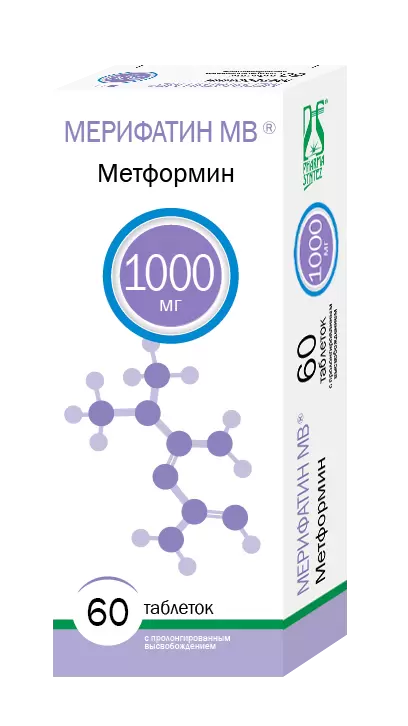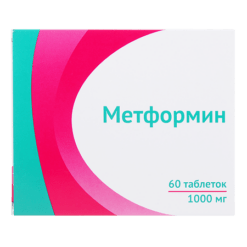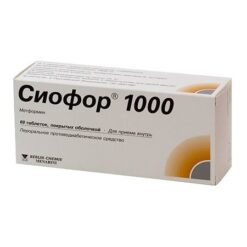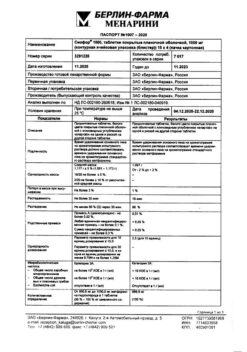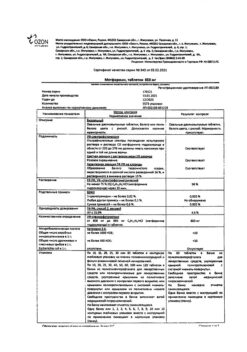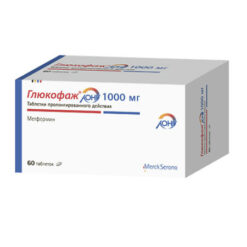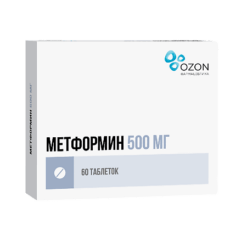No products in the cart.
Merifatin MB, 1000 mg 60 pcs
€1.00
Out of stock
(E-mail when Stock is available)
Description
Pharmacotherapeutic group
Hypoglycemic drug for oral use of the biguanide group.
ATX code: A10VA02
Pharmacological properties Pharmacodynamics
Metformin is a biguanide with hypoglycemic action that reduces both basal and postprandial plasma glucose concentrations. It does not stimulate insulin secretion and therefore does not cause hypoglycemia. Increases the sensitivity of peripheral receptors to insulin and glucose utilization by cells. Reduces glucose production by the liver by inhibiting gluconeogenesis and glycogenolysis. Delays glucose absorption in the intestine.
Metformin stimulates glycogen synthesis by acting on glycogen synthase. Increases transport capacity of all types of membrane glucose transporters.
When taking metformin, patient’s body weight either remains stable or decreases moderately. Metformin has a favorable effect on lipid metabolism: it reduces total cholesterol, LDL (low-density lipoproteins), and triglycerides.
Pharmacokinetics
Absorption
.After a single administration of sustained-release metformin (500 mg and 750 mg sustained-release tablets) at a dose of 1500 mg, the average time to reach the maximum plasma concentration of metformin (TSmax) is 5 h (range 4-12 h). After a single dose of 1 sustained-release metformin 1000 mg tablet after a meal, the mean TCmax is 5 h (range 4-10 h).
In an equilibrium state identical to that of metformin with normal release, maximum concentration (Cmax) and area under the “concentration-time” curve (AUC) increase not in proportion to the dose taken.
Individual variability in Cmax and AUC after a single dose of sustained-release metformin 2000 mg is similar to that observed after a dose of 1000 mg twice daily of normal-release metformin.
Individual variability in Cmax and AUC after administration of metformin in sustained-release tablet form is similar to that observed after administration of normal-release metformin.
After a single dose of sustained release metformin at a dose of 1000 mg after meal, AUC is increased by 77%, Cmax is increased by 26% and TCmax is increased by approximately 1 hour. Absorption of sustained-release metformin does not change according to the food intake.
No cumulation is observed with repeated administration of sustained-release metformin in doses up to 2000 mg.
Distribution
Metformin is rapidly distributed in tissues, almost does not bind to plasma proteins and is able to accumulate in erythrocytes. Cmax in blood is lower than Cmax in plasma and is reached in about the same time. Mean volume of distribution is 63-276 L.
Metabolism
It is metabolized to a very low degree, no metabolites were found in the body. Elimination
Extracted by the kidneys unchanged. Metformin clearance in healthy volunteers is over 400 ml/min (4 times greater than creatinine clearance), indicating active tubular secretion.
The elimination half-life is approximately 6.5 h.
Kidney function impairment
.If renal function is impaired, metformin clearance decreases in proportion to creatinine clearance (CK), respectively, the elimination half-life is increased, plasma concentrations of metformin are increased, and the risk of cumulation increases.
Indications
Indications
Diabetes mellitus type 2 in adults (especially in obese patients) when diet therapy and physical activity are ineffective:
Active ingredient
Active ingredient
Composition
Composition
How to take, the dosage
How to take, the dosage
Ingestion. The tablets should be swallowed whole without chewing and with plenty of fluids, once daily with dinner.
The dosage of Merifatin MB is adjusted individually by the physician for each patient based on the results of blood glucose measurements.
Adult patients with normal renal function (CKR â¥90 mL/min)
Monotherapy and combination therapy in combination with other hypoglycemic agents
Blood glucose concentrations. Slow dose increases help to reduce gastrointestinal (GI) side effects.
Combination with insulin
To achieve better blood glucose control, metformin and insulin may be used as combination therapy. The usual starting dose of Merifatin MB is 1 tablet 500 mg once daily or 750 mg once daily with dinner, while the insulin dose is adjusted based on blood glucose readings. Subsequently, conversion to Merifatin MB at a dose of 1000 mg is possible.
Daily dose
The maximum recommended dose of Merifatin MB is 4 tablets 500 mg daily (2000 mg) or 3 tablets 750 mg daily (2250 mg) or 2 tablets of 1000 mg daily (2000 mg). If adequate glycemic control is not achieved by taking the maximum recommended dose once daily at dinner, then the maximum dose may be divided into two doses: 2 tablets 500 mg at breakfast and 2 tablets 500 mg at dinner, or one tablet 1000 mg at breakfast and one tablet 1000 mg at dinner. If adequate glycemic control is not achieved with the maximum recommended dose of Merifatin MB prolonged release tablets, conversion to metformin with normal release active ingredient at a maximum daily dose of 3000 mg is possible.
The use of the drug in special clinical groups of patients Dose skipping
If the next dose is missed, the next dose should be taken at the usual time. Do not take a double dose of Merifatin MB.
Patients with renal impairment
Metformin may be used in patients with renal impairment with a CK of 30-59 mL/min only if there are no conditions/risk factors that may increase the risk of lactoacidosis.
Renal function should be monitored closely: CK should be determined every 3-6 months in patients with CK of 45-59 mL/min and every 3 months with CK of 30-44 mL/min.
If creatinine clearance is below 30 mL/min, metformin should be stopped immediately.
Creatinine clearance (ml/min)
Maximum daily dose (divided into 2-3 doses per day)
Additional information
60-89
3000 mg
/p>
Decreasing the dose of metformin should be considered due to decreased renal function.
45-59
2000 mg
Before starting therapy with metformin, factors that increase the risk of lactoacidosis should be investigated (see Caution section). The starting dose is half of the maximum
daily dose
30-44
/p>
1000 mg
< 30
–
Taking metformin
is contraindicated.
Patients of advanced age
.Because of a possible decrease in renal function, the dose of metformin is adjusted based on renal function assessment, which should be performed regularly (See “Special Instructions. “Special Indications”).
Children and adolescents under 18 years
The use of the drug is contraindicated in children and adolescents under 18 years of age (due to lack of clinical data on efficacy and safety).
Length of treatment
Merifatin MB should be taken daily, without interruption. The patient should notify the physician if treatment is stopped.
Merifatin MB should be taken daily without interruption.
Interaction
Interaction
Contraindicated combinations
Iodine-containing radiopaque agents: In a background of functional renal insufficiency in patients with diabetes mellitus, radiological examination with iodine-containing radiopaque agents may cause the development of lactoacidosis. Metformin administration should be discontinued depending on renal function 48 hours prior to or at the time of radiology with iodine-based radiopaque agents and should be restarted not earlier than 48 hours after, on condition that renal function was found to be normal during the examination.
Unrecommended combinations
Alcohol: Acute alcohol intoxication increases the risk of lactoacidosis, especially if:
You should not drink alcohol or take any medicinal products containing ethanol during therapy with the drug.
Combinations requiring caution
Drugs (drugs) with indirect hyperglycemic effects (e.g., GCS (systemic and topical) and tetracosactide, β2adrenomimetics, danazol, chlorpromazine when taken at high doses (100 mg per day) and diuretics: m may require more frequent monitoring of blood glucose concentrations, especially at the beginning of treatment. If necessary, the dose of Merifatin MB may be adjusted during treatment and after discontinuation based on glycemic levels.
Diuretics: Simultaneous use of “loop” diuretics may lead to the development of lactoacidosis due to possible functional renal failure.
The concomitant use of Merifatin MB with sulfonylurea derivatives, insulin, acarbose, salicylates may lead to hypoglycemia.
Nifedipine increases absorption and Cmax of metformin.
Cationic drugs .(amiloride, digoxin, morphine, procainamide, quinidine, quinine, ranitidine, triamterene, trimethoprim, and vancomycin) that are secreted in the renal tubules compete with metformin for tubular transport systems and may lead to increased Cmax.
Colesevelam when used concomitantly with metformin in the form of sustained-release tablets increases plasma metformin concentrations (increases AUC without significantly increasing Cmax).
Peroral contraceptives, epinephrine, glucagon, thyroid hormones, phenothiazine derivatives, nicotinic acid
.The hypoglycemic effect of metformin may decrease phenothiazides, glucagon, estrogens, oral contraceptives, phenytoin, sympathomimetics, nicotinic acid, isoniazid, “slow” calcium channel blockers, levothyroxine sodium.
Simultaneous use with cimetidine reduces metformin excretion rate, which may lead to lactoacidosis.
In healthy volunteers, no changes in their pharmacokinetic parameters were observed when metformin and propranolol and when metformin and ibuprofen were used concomitantly.
Metformin may decrease the effect of indirect-acting anticoagulants. Organic cation transporter substrates 1 and 2 (OCT1 and OCT2) Metformin is a substrate of organic cations OCT1 and OCT2.
When co-administered with metformin:
Special Instructions
Special Instructions
Lactoacidosis
Lactoacidosis is a rare but serious (high mortality if not treated urgently) complication that can occur due to metformin cumulation. Cases of lactoacidosis when taking metformin have occurred mainly in patients with diabetes mellitus with severe renal insufficiency.
Synopsis
Synopsis
Contraindications
Contraindications
Side effects
Side effects
Categorization of the incidence of HF when using the drug according to World Health Organization (WHO) recommendations: very frequently (â¥1/10); frequently (â¥1/100, <1/10); infrequently (â¥1/1000, <1/100); rarely (â¥1/10000, <1/1000); very rarely (<1/10000).
Metabolic side: very rarely – lactoacidosis (see “Special Precautions”).
In long-term administration of metformin, decreased absorption of vitamin B12 may be observed. If megaloblastic anemia is detected, the possibility of this etiology should be considered.
Nervous system disorders: frequent – taste disorder (metallic taste in the mouth).
Gastrointestinal side: very often – nausea, vomiting, diarrhea, abdominal pain and lack of appetite. They occur most frequently during the initial period of treatment and in most cases spontaneously disappear. It is recommended that metformin be taken with or after meals to prevent the symptoms. Slowly increasing the dose may improve tolerability on the gastrointestinal side.
Hepatic and biliary tract disorders: very rarely, impaired liver function parameters and hepatitis; these HPs disappear completely after discontinuation of the drug.
Skin and subcutaneous tissue disorders: very rarely – skin reactions such as erythema (skin redness), itching, urticaria.
If any of the HFs listed in the instructions worsened or other HFs not listed in the instructions appeared, you should tell your doctor.
Overdose
Overdose
Pregnancy use
Pregnancy use
Similarities
Similarities
Additional information
| Shelf life | 3 years. Do not use after the expiration date. |
|---|---|
| Conditions of storage | Store in a light-protected place at a temperature not exceeding 25˚C. Keep out of reach of children. |
| Manufacturer | Pharmasintez-Tyumen, Russia |
| Medication form | controlled release tablets |
| Brand | Pharmasintez-Tyumen |
Other forms…
Related products
Buy Merifatin MB, 1000 mg 60 pcs with delivery to USA, UK, Europe and over 120 other countries.

